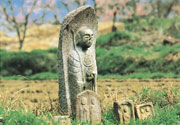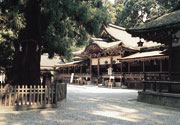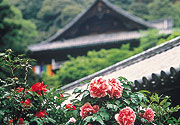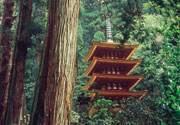 |
 |
| Feel the legacy
of ancient poets |
|
 |
 The
Yamanobe-no-michi extends from the foot of Mt. Kasuga to Tsubaichi
in Sakurai City, where you can trace the legacy of ancient
poets. Now the path has been improved as a walking course
starting from Isonokami Shrine, giving walkers views of beautiful
scenery and ancient buildings along the way. Omiwa Shrine,
in the middle of the course has no main shrine buildings;
rather, the whole of Mt. Miwa is the object of worship. On
the mountain, there are three Iwakura, or sacred rocks, to
which deities are said to descend. The
Yamanobe-no-michi extends from the foot of Mt. Kasuga to Tsubaichi
in Sakurai City, where you can trace the legacy of ancient
poets. Now the path has been improved as a walking course
starting from Isonokami Shrine, giving walkers views of beautiful
scenery and ancient buildings along the way. Omiwa Shrine,
in the middle of the course has no main shrine buildings;
rather, the whole of Mt. Miwa is the object of worship. On
the mountain, there are three Iwakura, or sacred rocks, to
which deities are said to descend.
 0743-68-1911
(Tenri City Tourist Information Center) and 0744-44-2377 (Sakurai
Tourist Information Center) 0743-68-1911
(Tenri City Tourist Information Center) and 0744-44-2377 (Sakurai
Tourist Information Center)
 Admission
free Admission
free |
 |
| Mt. Miwa itself
is the object of worship |
|
 |
 This
shrine, one of the oldest in Japan, includes the whole of
Mt. Miwa within its bounds, and is otherwise known as Miwa
Myojin. In the sanctuary is a large, sacred Japanese cedar
tree. An old story says that a white snake living in the sanctuary
is a reincarnation of the deity, Miwa Myojin. The shrine is
particularly associated with sake, pharmaceuticals and warding
off bad luck, and still attracts many worshippers, including
sake and liquor producers from throughout the nation. This
shrine, one of the oldest in Japan, includes the whole of
Mt. Miwa within its bounds, and is otherwise known as Miwa
Myojin. In the sanctuary is a large, sacred Japanese cedar
tree. An old story says that a white snake living in the sanctuary
is a reincarnation of the deity, Miwa Myojin. The shrine is
particularly associated with sake, pharmaceuticals and warding
off bad luck, and still attracts many worshippers, including
sake and liquor producers from throughout the nation.
 0744-42-6633 0744-42-6633
 Admission
Free Admission
Free
 A
10-minute walk from JR Miwa Station / Take bus No.34 from
JR Sakurai Station and get off at Miwa Myojin Sando Guchi.
A 15-minute walk from the bus stop A
10-minute walk from JR Miwa Station / Take bus No.34 from
JR Sakurai Station and get off at Miwa Myojin Sando Guchi.
A 15-minute walk from the bus stop |
 |
| A temple to Kannon
surrounded by peony gardens |
|
 |
 The
main hall of Hasedera Temple is one of the biggest halls of
all the temples in Nara, extending southwards on a raised
stage. 'Juichimen Kannon', a eleven-faced divine savior of
all the people in the world, has ten faces on the top of its
main face. The statue of 'Juichimen Kannon,' which is about
10m in height, is covered in gold. Hasedera Temple is famous
for its peony garden and has 7,000 plants and 150 species
of peony planted in the grounds. It is a breath taking site
when they are in full bloom. The
main hall of Hasedera Temple is one of the biggest halls of
all the temples in Nara, extending southwards on a raised
stage. 'Juichimen Kannon', a eleven-faced divine savior of
all the people in the world, has ten faces on the top of its
main face. The statue of 'Juichimen Kannon,' which is about
10m in height, is covered in gold. Hasedera Temple is famous
for its peony garden and has 7,000 plants and 150 species
of peony planted in the grounds. It is a breath taking site
when they are in full bloom.
 0744-47-7001
/ April to September: 8:30 - 17:00, For other seasons : 9:00
- 16:30 / Open 7 days a week 0744-47-7001
/ April to September: 8:30 - 17:00, For other seasons : 9:00
- 16:30 / Open 7 days a week
  500 500
 A 20-minute walk from Kintetsu Hasedera Station / Take bus
No. 55 from JR or Kintetsu Sakurai Station and get off at
Hasedera Mae.
A 20-minute walk from Kintetsu Hasedera Station / Take bus
No. 55 from JR or Kintetsu Sakurai Station and get off at
Hasedera Mae.
 Main
events : Dadaoshi (a ritual of chasing ogres) : Feb.14 Main
events : Dadaoshi (a ritual of chasing ogres) : Feb.14 |
 |
| A rhododendron
temple open to women worshippers (Nyonin Koya) |
|
 |
 It's
five-storied pagoda, only 16.7m in height, is the smallest
of its kind in Japan. The temple is dedicated to 'Shaka Nyorai'
Buddha, a founder of Buddhism, and the statue, 105.5cm in
height, imparts the flavor of the 9th century Buddhist arts
to modern visitors. While the famous Mt. Koya (Kongobuji Temple),
home of Shingon Sect Buddhism, closes its doors to women worshippers,
Murouji Temple, practicing the same Shingon Sect Buddhism,
accepts them. This temple is also famous for its beautiful
rhododendrons. It's
five-storied pagoda, only 16.7m in height, is the smallest
of its kind in Japan. The temple is dedicated to 'Shaka Nyorai'
Buddha, a founder of Buddhism, and the statue, 105.5cm in
height, imparts the flavor of the 9th century Buddhist arts
to modern visitors. While the famous Mt. Koya (Kongobuji Temple),
home of Shingon Sect Buddhism, closes its doors to women worshippers,
Murouji Temple, practicing the same Shingon Sect Buddhism,
accepts them. This temple is also famous for its beautiful
rhododendrons.
 0745-93-2003
/ 8:00 - 17:00, 8:30 - 16:00 (12/1 - 1/31) (Subject to change
by seasons) / Open 7 days a week 0745-93-2003
/ 8:00 - 17:00, 8:30 - 16:00 (12/1 - 1/31) (Subject to change
by seasons) / Open 7 days a week
  500 500
 Take
bus No. 43, 44, 45 or 46 from Kintetsu Murou Guchi Ono Station
and get off at Murouji. A 5-minute walk from the bus stop Take
bus No. 43, 44, 45 or 46 from Kintetsu Murou Guchi Ono Station
and get off at Murouji. A 5-minute walk from the bus stop |
|

